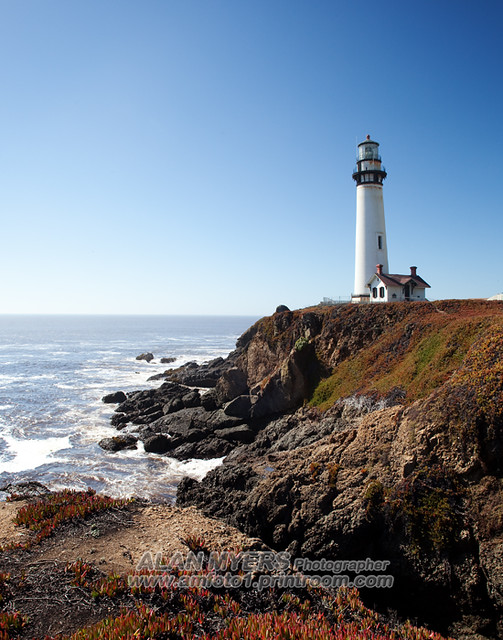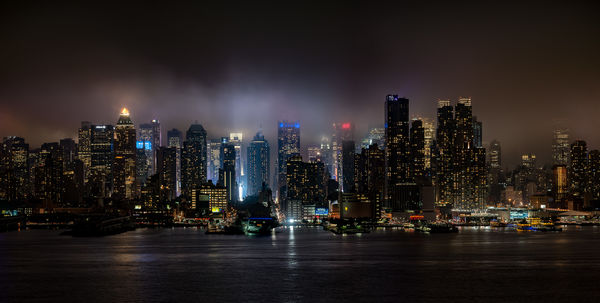Prime lenses
Jul 19, 2016 14:39:06 #
WF2B wrote: This is a great example of why I also like my telephotos for some of my landscape shots.
This is a great example of why I also like my telephotos for some of my landscape shots.
Bud
 This is a great example of why I also like my telephotos for some of my landscape shots.
This is a great example of why I also like my telephotos for some of my landscape shots.Bud
Thank you!
And here is one taken with a 100-300mm F4 zoom, set to 100mm, and another night shot taken with an 85mm prime. The distance from camera to skyline is a little over a mile.
Jul 19, 2016 15:12:57 #
Robeng
Loc: California
Bumtree wrote:
Are prime lenses good for landscape photography. (135 Canon L)
The short answer is yes. Take a moment and find some outdoor websites and read what the pros use and why.
Jul 19, 2016 15:52:13 #
amfoto1
Loc: San Jose, Calif. USA
Bumtree wrote:
Are prime lenses good for landscape photography. (135 Canon L)
The Canon 135/2L is a great lens! It's a bit "legendary" among Canon shooters. Used wide open it has a really dreamy effect, strongly blurring backgrounds, making it great for portraits. Stopped down a little it gets very sharp. And it's quite fast focusing, so excellent for sports/action shooting.
But, to be honest, it's probably one of the last lenses I'd use for landscape photography. Not that there's anything "wrong" with the lens, just that I wouldn't commonly use a telephoto like the 135mm for that purpose. Yes, there might be occasions that a telephoto is used for landscape shots... there certainly are no "rules" against it. But, IMO, it would be a rather specialized and rare use for this type lens.
My most frequently used landscape lenses on my full frame camera are Canon 20mm, 24mm, 28mm, 45mm and 50mm. I don't have it yet, but eventually plan get the EF 35mm f2.0 IS USM, too.That would be another I'd be likely to use for landscapes. (But I also use zooms... 24-70mm. Don't have it yet, but may buy the 16-35mm f4L IS USM in the future.)
On my crop sensor cameras, I use the same 20mm and 28mm sometimes for landscapes, but Canon 10-22mm and Tokina 12-24mm a lot (there just aren't many truly wide primes available for crop cameras, so it's down to the zooms instead).
A couple examples shot with Canon EF 20mm f2.8 USM lens:
20/2.8 on full frame camera (5DII) with B+W CPL filter...

And, 20/2.8 on APS-C crop sensor camera (50D) with B+W CPL filter...

Jul 19, 2016 16:19:26 #
Sorry if I repeat, but I just couldn't bring myself to read past the first page before replying. Being old, and thus having been involved for close to 50 years, I have a thought. Back in the days of film (?) most lenses were fixed focal length or prime. When zoom lenses first came into being, there was some real junk and no "real" photographer would be caught using one, including me. They were for the lazy! Nowadays there are some superb zoom lenses that I just could not live without. Nikon's "holy trinity" comes to mind. I use and carry both as each type has a purpose in my work. There is not "correct" answer to your question. Use whichever lens makes you happy. For a walkaround today, I usually use either my 24-70/2.8 or 24-105/4.0. Best of luck. Shoot & have fun!
Jul 19, 2016 16:21:49 #
Yes, absolutely, as well as for many other things.
--Bob
--Bob
Bumtree wrote:
Are prime lenses good for landscape photography. (135 Canon L)
Jul 19, 2016 16:50:36 #
amfoto1
Loc: San Jose, Calif. USA
A bit of a historical side trip...
This is probably a typo. More likely, that was a "Contaflex" camera.
That same inventory (purportedly from 1957) was published on the George Eastman House museum website some time ago, during an Adams exhibit.
There was a "Koniflex" 35mm camera around close to that time... but only a couple of them were produced as prototypes. Instead, when put into production in 1960 the model was called the "Konica F", as seen here:

However, the Konica F wasn't produced until 1960, when it was the first camera to offer 1/2000 shutter speed and the first Japanese 35mm SLR to have a built-in, cross-coupled light meter. It also used a precursor to the Copal Square shutter that revolutionized 35mm SLRs in the 1960s, that's the basic design for the shutters used in most SLRs after that and even those found in most DSLRs today. The Konica F was also one of the first SLRs to have 1/125 flash sync (others only had 1/30 or 1/60 at that time... some still did even 15 years later). The Konica F was only produced for one year and in very small quantities (it's estimated that might be as few as 500 or 600, likely no more than 1000, even though serial numbers as high as 1500 are known).
In the mid-1950s there were also Koniflex and Koni-Teleflex twin lens reflex (TLR), medium format cameras, 6x6 cm format (http://camerapedia.wikia.com/wiki/Koniflex).
And, there was a low cost, basic "Konilette 35" rangefinder (1959):

Very likely it's the similarity of the names of these other models that the Konica F name was used instead (not to mention Nikon had introduced their own "F" about a year earlier).
Close inspection and identification of the camera shown in the Ansel Adams film isn't easy, due to the image quality.... But it doesn't look like a Konica F or the Koniflex prototypes. Instead it's most likely a Zeiss Ikon "Contaflex" III (meterless) or IV (built-in, uncoupled meter), introduced in 1956. There also seem to be some accessory lenses with Adams' camera, which were first made available with these two models. (Prior Contaflex models only had a fixed, non-interchangeable lens.) These were actually "lens heads", rather than fully interchangeable lenses: 35mm, 50mm, 85mm and 105mm focal lengths, plus a macro. With this design, the lens heads all utilize the same rear elements with integral leaf shutter assembly. More info here: http://pacificrimcamera.com/pp/zicontaflex1.htm
Plus, one of Ansel Adams' very first cameras in the 1930s was a Zeiss.... So he already had some history using them.
rgrenaderphoto wrote:
... Ansel Adams's photographic gear:
"... Item: One Koniflex 35 millimeter camera... "
"... Item: One Koniflex 35 millimeter camera... "
This is probably a typo. More likely, that was a "Contaflex" camera.
That same inventory (purportedly from 1957) was published on the George Eastman House museum website some time ago, during an Adams exhibit.
There was a "Koniflex" 35mm camera around close to that time... but only a couple of them were produced as prototypes. Instead, when put into production in 1960 the model was called the "Konica F", as seen here:

However, the Konica F wasn't produced until 1960, when it was the first camera to offer 1/2000 shutter speed and the first Japanese 35mm SLR to have a built-in, cross-coupled light meter. It also used a precursor to the Copal Square shutter that revolutionized 35mm SLRs in the 1960s, that's the basic design for the shutters used in most SLRs after that and even those found in most DSLRs today. The Konica F was also one of the first SLRs to have 1/125 flash sync (others only had 1/30 or 1/60 at that time... some still did even 15 years later). The Konica F was only produced for one year and in very small quantities (it's estimated that might be as few as 500 or 600, likely no more than 1000, even though serial numbers as high as 1500 are known).
In the mid-1950s there were also Koniflex and Koni-Teleflex twin lens reflex (TLR), medium format cameras, 6x6 cm format (http://camerapedia.wikia.com/wiki/Koniflex).
And, there was a low cost, basic "Konilette 35" rangefinder (1959):

Very likely it's the similarity of the names of these other models that the Konica F name was used instead (not to mention Nikon had introduced their own "F" about a year earlier).
Close inspection and identification of the camera shown in the Ansel Adams film isn't easy, due to the image quality.... But it doesn't look like a Konica F or the Koniflex prototypes. Instead it's most likely a Zeiss Ikon "Contaflex" III (meterless) or IV (built-in, uncoupled meter), introduced in 1956. There also seem to be some accessory lenses with Adams' camera, which were first made available with these two models. (Prior Contaflex models only had a fixed, non-interchangeable lens.) These were actually "lens heads", rather than fully interchangeable lenses: 35mm, 50mm, 85mm and 105mm focal lengths, plus a macro. With this design, the lens heads all utilize the same rear elements with integral leaf shutter assembly. More info here: http://pacificrimcamera.com/pp/zicontaflex1.htm
Plus, one of Ansel Adams' very first cameras in the 1930s was a Zeiss.... So he already had some history using them.
Jul 19, 2016 17:32:47 #
Bumtree wrote:
Are prime lenses good for landscape photography. (135 Canon L)
I see some people trying to confuse you.
If the prime is the focal length you want to use, then its perfect for the job.
Jul 19, 2016 17:33:55 #
Jim Bob wrote:
No. They can only be used for portraits. They are horrible for landscapes. Geesus.
Someone should have informaed Ansel Adams. Perhaps he could have improved his landsscaps. - Dave
Jul 19, 2016 17:50:34 #
I use a 150mm for landscapes quite frequently. I know. It's not a 135, but it's close.
--Bob
--Bob
mas24 wrote:
I have never known anyone to use a 135mm prime for landscape. I still own a rarely used 28mm prime, and consider it borderline wide angle. I was considering a Nikon 20mm prime, but changed my mind because it just wasn't practical for my needs on a DX camera. I will consider instead a third party wide zoom lens.
Jul 19, 2016 17:55:55 #
rmalarz wrote:
I use a 150mm for landscapes quite frequently. I know. It's not a 135, but it's close.
--Bob
--Bob
What format? 150mm would be my choice if I were shooting 5X7. - Dave
Jul 19, 2016 18:11:33 #
Close, Dave. 4x5.
--Bob
--Bob
wilsondl2 wrote:
What format? 150mm would be my choice if I were shooting 5X7. - Dave
Jul 19, 2016 18:24:39 #
Great comments.
Two issues about choosing a lens for landscapes that I've not seen mentioned here:
-Risk of composing a wider scene than the scene justifies, given the layout of the scene -- because you choose your widest lens or zoom setting
-Too much compression or the opposite -- again due to lens choice
Two issues about choosing a lens for landscapes that I've not seen mentioned here:
-Risk of composing a wider scene than the scene justifies, given the layout of the scene -- because you choose your widest lens or zoom setting
-Too much compression or the opposite -- again due to lens choice
Edia wrote:
The benefit of prime lenses is that you can get la... (show quote)
Jul 19, 2016 18:34:05 #
Bumtree wrote:
Are prime lenses good for landscape photography. (135 Canon L)
No
Jul 19, 2016 19:18:31 #
All these responses are accurate, even the sarcastic ones. I have used a Nikon 14-24mm f2.8G, and a Tamrom 24-70mm f2.8 most of the time. Both give excellent results.
Jul 19, 2016 20:04:56 #
wj cody
Loc: springfield illinois
Robeng wrote:
The short answer is yes. Take a moment and find some outdoor websites and read what the pros use and why.
hey, Alan, am i looking at Morro Bay in your photo? sure looks like it to me. if you live around there, i hate you!!!!
kindest (sort of) regards, the very jealous,
wj cody
If you want to reply, then register here. Registration is free and your account is created instantly, so you can post right away.








